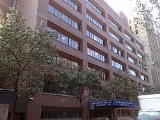
Bank Street College of Education
Encyclopedia
Bank Street College of Education is located in Manhattan
, New York City
.
). Its original focus was the study of child development
and education, but, after two years, it was clear that actual living subjects, i.e. children, were needed, so in 1918 a nursery school
was opened. This nursery school is the direct predecessor of today's School for Children. It wasn't until the 1930s that Bank Street began to formally train teachers
, the start of today's Bank Street College of Education.
In 1965, Bank Street developed the "Bank Street Readers" line of books, which were unique due to their featuring of racial diversity
and urban people of contemporary culture. Also in the 1960s, the Bank Street faculty played an important role in the creation of the federal Head Start program.
The college gets its name from its former location on Bank Street
in Greenwich Village
. It moved to its current location in the early 1970s.
Manhattan
Manhattan is the oldest and the most densely populated of the five boroughs of New York City. Located primarily on the island of Manhattan at the mouth of the Hudson River, the boundaries of the borough are identical to those of New York County, an original county of the state of New York...
, New York City
New York City
New York is the most populous city in the United States and the center of the New York Metropolitan Area, one of the most populous metropolitan areas in the world. New York exerts a significant impact upon global commerce, finance, media, art, fashion, research, technology, education, and...
.
History
Bank Street was founded in 1916 by Lucy Sprague Mitchell as the "Bureau of Educational Experiments". (Mitchell was the first Dean of Women at the University of California, BerkeleyUniversity of California, Berkeley
The University of California, Berkeley , is a teaching and research university established in 1868 and located in Berkeley, California, USA...
). Its original focus was the study of child development
Child development
Child development stages describe theoretical milestones of child development. Many stage models of development have been proposed, used as working concepts and in some cases asserted as nativist theories....
and education, but, after two years, it was clear that actual living subjects, i.e. children, were needed, so in 1918 a nursery school
Nursery school
A nursery school is a school for children between the ages of one and five years, staffed by suitably qualified and other professionals who encourage and supervise educational play rather than simply providing childcare...
was opened. This nursery school is the direct predecessor of today's School for Children. It wasn't until the 1930s that Bank Street began to formally train teachers
Teacher education
Teacher education refers to the policies and procedures designed to equip prospective teachers with the knowledge, attitudes, behaviors and skills they require to perform their tasks effectively in the classroom, school and wider community....
, the start of today's Bank Street College of Education.
In 1965, Bank Street developed the "Bank Street Readers" line of books, which were unique due to their featuring of racial diversity
Multiculturalism
Multiculturalism is the appreciation, acceptance or promotion of multiple cultures, applied to the demographic make-up of a specific place, usually at the organizational level, e.g...
and urban people of contemporary culture. Also in the 1960s, the Bank Street faculty played an important role in the creation of the federal Head Start program.
The college gets its name from its former location on Bank Street
Bank Street (Manhattan)
Bank Street is a primarily residential street in the Greenwich Village section of New York City, in the borough of Manhattan. It runs from West Street to Hudson Street, and Bleecker Street to Greenwich Avenue...
in Greenwich Village
Greenwich Village
Greenwich Village, , , , .in New York often simply called "the Village", is a largely residential neighborhood on the west side of Lower Manhattan in New York City. A large majority of the district is home to upper middle class families...
. It moved to its current location in the early 1970s.

